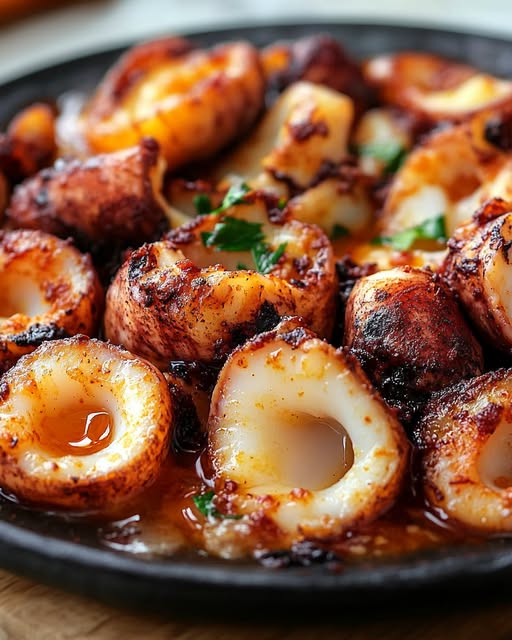Discover the Magic of Galician Octopus Delight
Picture this: a sunny afternoon in a seaside village, where the salty breeze carries the aroma of something truly special. That’s how I first encountered Galician Octopus Delight, or as the Spanish call it, Pulpo a la Gallega. It was love at first bite. Tender, flavorful octopus paired with smoky paprika and silky olive oil? Yes, please! This dish is simple yet unforgettable, and today, I’m sharing my take on this Spanish classic. Whether you’re hosting a dinner party or craving something new, this recipe will have your taste buds dancing flamenco.
A Taste of Galicia: The Story Behind the Dish
This dish hails from Galicia, a lush region in northwest Spain known for its seafood. Traditionally served at festivals and family gatherings, Pulpo a la Gallega is a celebration of simplicity. Back in the day, fishermen would cook octopus in copper pots over open fires right on the beach. Over time, the recipe made its way into homes and restaurants worldwide. My first attempt at making it was a bit of a disaster—I overcooked the octopus, and it turned rubbery. But after some trial and error (and a lot of paprika), I nailed it. Now, it’s a staple at my house, especially during summer barbecues.
Why You’ll Love This Recipe
What makes Galician Octopus Delight so irresistible? First, it’s incredibly easy to prepare—just 10 minutes of prep and 40 minutes of cooking. Second, the flavors are bold yet balanced. The tender octopus absorbs the rich olive oil and smoky paprika, creating a symphony of taste. Plus, it’s naturally gluten-free and packed with protein. Whether you’re a seasoned chef or a kitchen newbie, this recipe is foolproof and rewarding.
Perfect Occasions for Galician Octopus Delight
This dish is perfect for any occasion where you want to impress without breaking a sweat. Serve it as an appetizer at a dinner party, bring it to a potluck, or enjoy it as a light lunch with friends. It pairs beautifully with crisp white wine or a refreshing sangria. I once made it for a holiday gathering, and my guests couldn’t stop raving about it. Trust me, it’s a crowd-pleaser!
Ingredients List
- 1.5 kg of octopus, frozen then thawed
- 1 bay leaf
- 1 tablespoon of salt
- 2-3 tablespoons of high-quality olive oil
- Spanish paprika, to taste
- Salt, to taste
- 500 g of boiled, sliced new potatoes (optional)
Substitution Options
If you can’t find fresh or frozen octopus, canned baby octopus works in a pinch. Swap Spanish paprika for smoked paprika if needed, but the flavor won’t be quite the same. For a lighter version, use a mild olive oil instead of extra virgin. And if you’re not a fan of potatoes, serve the octopus over warm crusty bread or alongside a fresh salad.
Preparation Steps
Step 1: Boil the Water
Fill a large pot halfway with water and bring it to a rolling boil. Add the bay leaf and a tablespoon of salt. The bay leaf adds a subtle herbal note that complements the octopus perfectly. Pro tip: Use filtered water if possible—it makes a difference in flavor. As the water heats up, you’ll notice the kitchen filling with a comforting, earthy aroma.
Step 2: Prepare the Octopus
Once the water is boiling, grab your thawed octopus by the head and dip it into the water three times quickly. This step is key to achieving that signature tender texture. After the third dip, let the octopus slide fully into the pot. The tentacles will curl slightly, adding to the dish’s rustic charm.
Step 3: Cook the Octopus
Cover the pot and reduce the heat to medium. Cook the octopus for about 18 minutes (or 12 minutes per kilogram). Keep an eye on the pot—you want the octopus to be tender but not mushy. Pro tip: If you’re unsure, test doneness by inserting a sharp knife into the thickest part of the tentacle. It should glide through effortlessly.
Step 4: Let It Rest
Turn off the heat and let the octopus rest in the hot water for 20 minutes. This resting period ensures even cooking and locks in moisture. While it rests, imagine the flavors melding together—the briny octopus soaking up the bay leaf’s fragrance and the salt’s gentle kiss.
Step 5: Slice and Serve
Remove the octopus from the pot and let it cool slightly before slicing the tentacles into bite-sized pieces. Arrange them on a platter, drizzle generously with olive oil, sprinkle with paprika, and add a pinch of salt. If using, place the slices atop boiled potatoes for a heartier presentation.
Chef’s Tip
To elevate your Galician Octopus Delight, toast the paprika lightly in a dry pan before sprinkling it over the dish. This intensifies its smoky flavor and adds a professional touch.
Timing Breakdown
- Prep Time: 10 minutes
- Cooking Time: 40 minutes (including resting)
- Total Time: 50 minutes
Extra Info
Did you know that freezing and thawing octopus helps break down its fibers, making it more tender? That’s why most recipes recommend starting with frozen octopus. It’s a little trick I learned from a Galician fisherman during one of my travels.
Necessary Equipment
You’ll need a large pot, tongs, a sharp knife, and a serving platter. A slotted spoon comes in handy for removing the octopus from the water.
Storage Tips
If you have leftovers, store them in an airtight container in the fridge for up to two days. Reheat gently in a pan with a splash of olive oil to prevent drying out. Avoid microwaving, as it can make the octopus tough.
For longer storage, freeze the cooked octopus in portions. Thaw overnight in the fridge before reheating. Keep in mind that the texture may change slightly after freezing.
Never refrigerate raw octopus unless it’s properly cleaned and prepped. Always follow safe food handling practices to avoid spoilage.
Tips and Advice
To ensure success, buy high-quality ingredients, especially the olive oil and paprikas. Don’t rush the resting period—it’s crucial for tenderness. Lastly, taste as you go. Adjust the seasoning gradually until it’s just right.
Presentation Ideas
- Serve on a wooden board for a rustic vibe.
- Garnish with fresh parsley for a pop of color.
- Pair with lemon wedges for a zesty twist.
Healthier Alternatives
Here are six variations to try:
- Grilled Octopus: Marinate the cooked octopus in olive oil, garlic, and herbs, then grill for a smoky finish.
- Octopus Salad: Toss sliced octopus with mixed greens, cherry tomatoes, and a citrus vinaigrette.
- Low-Sodium Version: Reduce the salt and use a potassium-based salt substitute.
- Vegan Option: Replace octopus with roasted mushrooms for a plant-based alternative.
- Spicy Kick: Add a dash of chili flakes or cayenne pepper for heat.
- Keto-Friendly: Skip the potatoes and serve the octopus over cauliflower rice.
Common Mistakes to Avoid
Mistake 1: Skipping the Dipping Step
Some cooks skip dipping the octopus into boiling water three times, thinking it’s unnecessary. Big mistake! This step helps tenderize the skin and prevents curling. Pro tip: Be patient and do it properly—it’s worth it.
Mistake 2: Overcooking the Octopus
Overcooked octopus becomes chewy and unpleasant. To avoid this, stick to the recommended cooking time and check for doneness frequently. Remember, it continues to cook slightly during the resting phase.
Mistake 3: Using Low-Quality Olive Oil
The olive oil is a star ingredient here, so don’t skimp. Use a high-quality extra virgin variety for the best flavor. Cheap oil can ruin the entire dish.
Mistake 4: Adding Too Much Paprika
A little paprika goes a long way. Start with a small amount and adjust to taste. Overdoing it can overpower the delicate flavors of the octopus.
FAQs About Galician Octopus Delight
Where Can I Buy Fresh Octopus?
Fresh octopus can be found at specialty seafood markets or online retailers. If unavailable, frozen octopus is a great alternative.
Can I Use Frozen Octopus?
Absolutely! In fact, freezing and thawing octopus improves its texture. Just make sure to thaw it completely before cooking.
What Type of Paprika Should I Use?
Spanish smoked paprika (Pimentón de la Vera) is ideal. It has a deep, smoky flavor that enhances the dish.
How Do I Know When the Octopus Is Done?
The octopus is ready when a knife slides easily into the thickest part of the tentacle. It should feel firm but not rubbery.
Can I Make This Dish Ahead of Time?
Yes, you can cook the octopus a day in advance and reheat it gently before serving. Store it in the fridge covered in olive oil.
Is This Dish Spicy?
No, it’s not spicy unless you add chili or hot paprika. Adjust the spice level to your preference.
What Can I Serve With This Dish?
Boiled potatoes, crusty bread, or a fresh salad pair beautifully with Galician Octopus Delight.
Can I Grill the Octopus After Boiling?
Definitely! Grilling adds a delicious charred flavor. Just brush the octopus with olive oil before grilling.
How Long Does It Last in the Fridge?
Stored properly, it lasts up to two days. Reheat gently to preserve the texture.
Is This Dish Gluten-Free?
Yes, it’s naturally gluten-free. Just ensure all your ingredients are certified gluten-free if needed.
Final Thoughts
Galician Octopus Delight is more than just a recipe—it’s a journey to the sun-drenched shores of Spain. With its vibrant flavors and simple preparation, it’s a dish that brings people together. So grab some octopus, fire up the stove, and let the magic unfold. Trust me, your family and friends will thank you. Happy cooking!

Galician Octopus Delight
Ingredients
Equipment
Method
- Fill a large pot halfway with water and bring it to a rolling boil. Add the bay leaf and a tablespoon of salt.
- Once the water is boiling, grab your thawed octopus by the head and dip it into the water three times quickly.
- After the third dip, let the octopus slide fully into the pot. Cover the pot and reduce the heat to medium.
- Cook the octopus for about 18 minutes (or 12 minutes per kilogram), checking for tenderness.
- Turn off the heat and let the octopus rest in the hot water for 20 minutes.
- Remove the octopus from the pot and let it cool slightly before slicing the tentacles into bite-sized pieces.
- Arrange the octopus on a platter, drizzle generously with olive oil, sprinkle with paprika, and add a pinch of salt.
